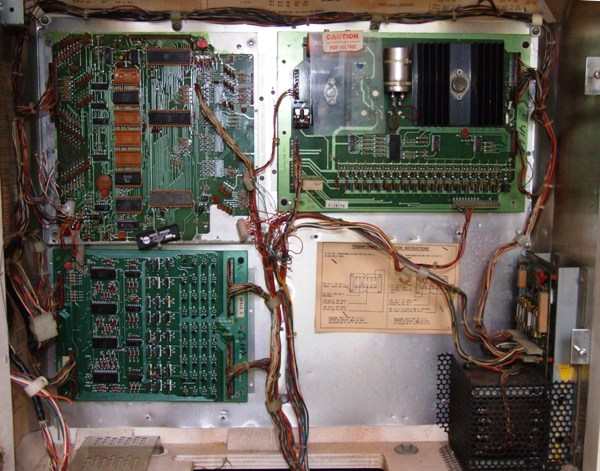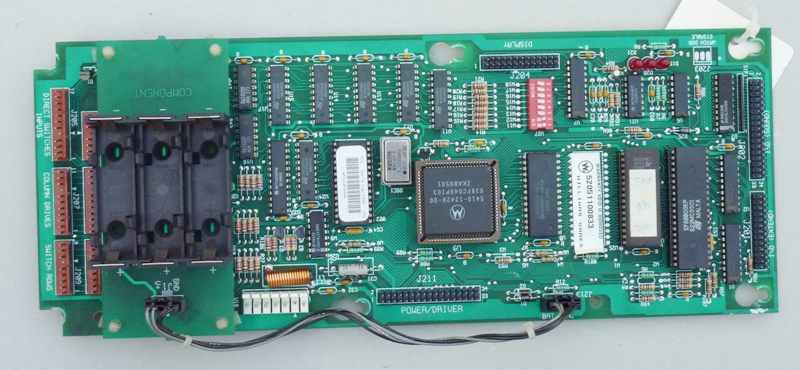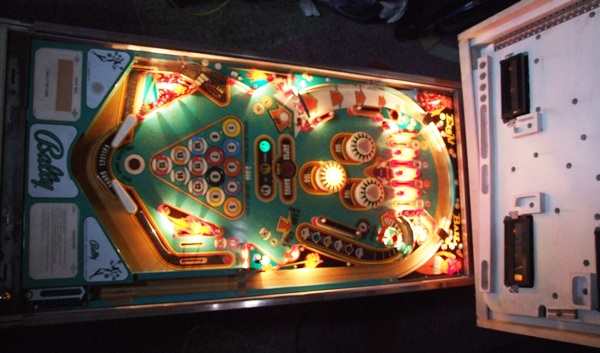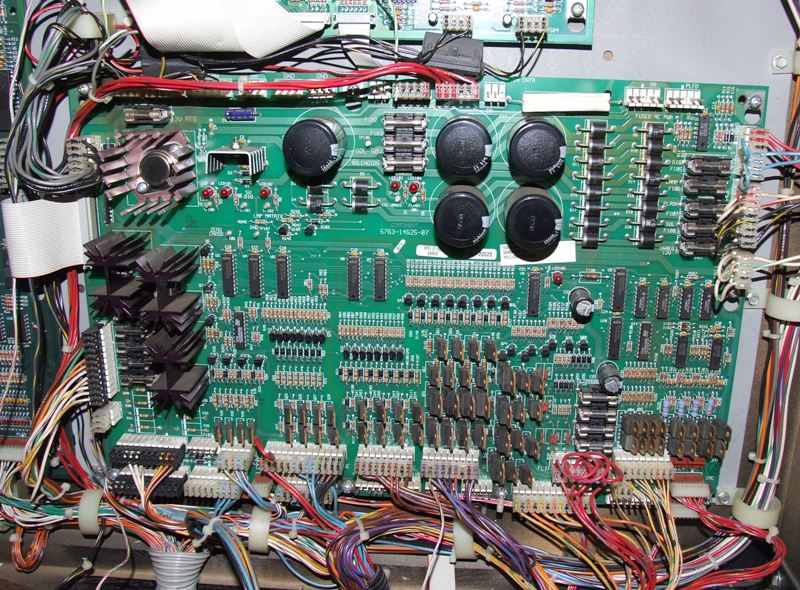Different circuits in electronic pinball machines
This article describes how electronic pinball machines operate (so not the pre-1977 electro-mechanical pinball machines).
The basics remain the same for every pinball machine, no matter what brand, or age.
There are some differences in implementation: sometimes circuits are split out over multiple pcbs, sometimes multiple circuits are joined on one pcb.
Contemporary games usually have extra boards/circuits than the older games.
As technology improved more features became possible, but still every basic functionality can be identified and remains the same on every pinball machine.
There may be exceptions to things I say, sometimes just about every pinball machine made works in a certain way except one manufacturer for some limited games..
my intention is to teach you about how pinball machines work in general, not go into every detailed exception.
I say circuits because they're electronically different circuits, but you can also consider it to be separate functions, tasks, areas, ..
Some basic knowledge of electronics is necessary to understand how pinball machines work and especially when you want to start doing your own repairs.
Basic circuits in a pinball machine
- Transformer
- Power supply / voltage regulation
- CPU
- General illumination
- Solenoid driver
- Lamp driver
- Sounds
- Score display
- Switch matrix

Standard backbox configuration of first generation Bally electronic games.
Top left: cpu board. Bottom left: lamp driver. Top right: solenoid driver board + display high voltage.
Bottom right: transformer with power board above it.
Transformer
Every pinball machine has a transformer. Its task is to take AC wall voltage and convert it into AC voltages that the pinball machine can use.
For me this circuit consists of the whole part from the wall plug until the transformers output, everything that works on the wall voltage (110 or 220 volts).
This includes fuses, an on/off switch, line filters, power surge protection, .. When lightning strikes usually some of these components are damaged, but they protect
the rest of the machine.
Usually this whole circuit is situated inside the bottom cabinet of a pinball machine. Only a few early Stern / Bally games had a transformer at the bottom right
side of the backbox.
Be very careful when working on this part of the pinball machine. Always be safe and unplug the pinball machine from the wall ! When working on other circuits this is not necessary - then it is safer to leave the machine switched off but plugged in, so there is still a ground connection.
See this article about pinball machines tripping house breakers to see how the line filter, fuses and power surge protection looks like on Williams WPC games.
Power supply / voltage regulation
This circuit takes the AC voltage that comes out of the transformer and converts it into other useable voltages.
Usually this circuit is one single board, but additional parts can be implemented over multiple boards, when that one single board requires specific voltages
that other boards don't (usually sound and score displays).
AC power coming out of the transformer is unregulated - it will fluctuate up and down. Not under load, voltages measured will be (mugh) higher than when you are playing a game and the circuit is under load. For instance on coils that have 50v, you can measure up to 70volts with your dmm when you are not playing the game. Wall voltage is not exactly 110 volts but can go up and down within a certain range.
One function of this circuit is creating regulated power. Some parts do need an exact voltage - a cpu board needs exactly +5vdc,
and any fluctiation (especially lower) will cause problems.
Bridge rectifiers (these are square metal parts) convert AC into DC power.
Capacitors will filter and smooth the power. other parts (like some transistors) convert voltages into other voltages.
Usually the circuits have extra fuses, testpoints and sometimes leds (to verify a certain power is present).
Output of this circuit is for instance +5v DC, which is used by circuit boards.
Score displays usually require high voltages. Some sound boards need 12v or 20v.
Some motors and special circuits also need specific voltages, they will have their own small voltage regulation circuits.
CPU - main processor unit
The cpu is the brain of the pinball machine. Usually it is a dedicated pcb. It controls the rest of the machine.
Once it is booted, it will control lamps, solenoids, sounds, score displays, .. It reacts to input (by switches on the playfield and cabinet) with a certain output
(lamps, sounds, score display, coils, ..)
If there is a problem with the cpu, the game will not start (or have weird behavior) and it is not possible to play.
The processing part itself has a reset function (which initialises the board when the game starts), a processer chip that executes instructions, the instructions themselves (usually on an EPROM, specific for each type of game) and memory chips where it can temporarily store things while executing the operations.

A-17651 Williams WPC-S security cpu board.
Largest IC (in socket) on the right is the processor. Left from it (with label) is an EPROM containing game rules. Left side of the board (underneath battery holder)
is the switch matrix part. Photo by Erik.
General illumination
GI is a circuit that provides power (usually around 6VAC) to the lightbulbs on the playfield and backbox that do not serve any function but to provide additional light on the game. They are just there so the game is not dark - this in contrast to lightbulbs that are controlled by the cpu and can be switched on and off individually and have as task to indicate something to players (more on these later).
Usually there are multiple strings (everything on one wire would put too much load on the circuit / connectors).
On older games they are directly connected to the output of the transformer. You could compare these to a string of Christmas lights.
So if you plug in a pinball machines and lights on the playfield work, it just indicates the transformer is working and the main fuse hasn't blown..
it doesn't mean you can play ! (as you need a working cpu for that).
On more modern games the cpu has some control over the GI. They are split up in a few strings (ie backbox, lower, middle and top of the playfield), and the cpu can control them: turn a string off, on, or set a specific brightness levels.

Only static lights, no blinking lights, nothing on the score displays ?
It's dead Jim..
Solenoid driver
This circuit takes input from the cpu and activates coils. It consists mostly of transistors and related components (resistors and diodes), a few ICs to interpret the signals from the cpu. The circuit to drive flashlamps can be included in this, as it is in function very closely related to that of the solenoids, and on some brands the circuits are combined.
Strictly speaking, providing power to the solenoids is not part of this circuit (it's part the power circuit).
On every electronic pinball machine, power is always present at the coils. The transistors on the solenoid driver board do not switch power on/off to specific coils,
but complete the path to ground to activate a coil. It's a subtle difference, but an important one when troubleshooting or trying to understand how the machine operates.
Usually there's a high and low power part. Some strong coils require a lot of power (up to 70 volts), and to handle this, a setup involving multiple transistors exists. Other coils, motors, work on a lower voltage. To drive these a slightly different type of circuit (involving less or other transistors) is used.

A-20028 WPC-95 power driver board. Most of the top half is the power part (fuses, thick diodes, black round capacitors), they smooth the voltage, change it into DC, ..
On the left are parts mounted on heath sinks, these are to dim the general illumination.
All the transistors at the bottom part are for lamps and solenoids.
Lamp driver
The lamp driver board is similar in function to the solenoid driver board: it allows the cpu to control specific lamps. That's the difference with GI lamps - controlled lamps can be individually switched on or off. Another difference is that controlled lamps have DC power, not AC. It's a small but important difference, you have to know on what setting to use on your DMM when you want to measure voltage on lamps on the playfield, as physically all lamps look the same.
Similar to the solenoid driver board, controlling lamps is done using transistors (or comparable parts like triacs). There is one important difference - while each coil is driven by an individual transistor, lamps are connected in a matrix.
As there are many lamps used on a pinball playfield, wiring each lamp individually would not be easy. For each lamp you'd need a wire, which going back to a connector
on the board, and an individual transistor.
Because the voltages are low, a lamp matrix could be implemented to simplify this. Think of a chess board with 8 rows and 8 colomns. Each of the squares is a lightbulb.
They are all connected using 16 wires: 8 for the rows, each wire goes from each lamp in the row to the next in that row. 8 column wires, also each one goes from the
first lamp in the column to the next. So only 16 wires and transistors are needed to control 64 bulbs.
To light specific bulbs, the cpu activates the first row. Then it'll activate the rows for the lightbulbs that need to be lit in that first row.
Those bulbs will light as both wires they have (row and column) get power.
Then the cpu deactivates the first row and does the same for the second, and so on. For each row the correct columns are switched on.
This process goes very quick. As filaments in lightbulbs do not immediately dim when power is cut, it looks to us like the lightbulbs are constant on,
while in reality they are turned on and off very quickly.
Sound circuit
There's not much to say about the sound circuit. It's an individual circuit that gets input from the cpu. Usually the input is limited (ie. play sound 1, 2, 3, ..). The sound circuit gets this input and does what's asked from it: play the specific sound.
This circuit also consists of different parts. One part is to process the input from the cpu. Another part generates the sound (this can be a simple sound generator chip, or eproms that contain specific sound samples). Lastly there's an amplifier part (which usually needs its own specific voltages) and the output of this sent connected to speakers.

Gottlieb Haunted House backbox.
Top left: power board. Top right: CPU.
Bottom right: Lamp + solenoid driver board.
Bottom left: sound board. Middle left: extra power board for sound board.
Far right center : extra lamp driver board.
Score display
The score display circuit is similar to the sound circuit. It's again a dedicated part that takes input from the cpu and does something with it. In its simplest form it'll do just show the score on a numeric display, but it can be more complicated things like show an animation on a dmd (and the animations are stored in eproms on the display driver board). Usually some kind of high voltage circuit is also involved.

Dot matrix display can show scores, text and animations.
Switch matrix
This is usually not considered to be a dedicated circuit, as it's mainly part of the cpu board. But as it's very similar to the lamp driver board I prefer to list it separate.
Most types of pinball machines have two types of input switches: direct and matrix.
The number of direct switches is usually limited (ie the service switches inside the coin door) and are connected individually to the cpu.
Most other switches on the playfield are hooked up in a matrix. Again like our lamp matrix, we have 8 wires for each row, and 8 wires for each column.
That way 64 switches can be connected to the cpu.
Operation is similar to the lamp matrix: the cpu sends a signal on the first row and checks on what columns it gets something back. Then it knows what switches are closed.
Then it sends a signal on the next row and again reads all columns, now it knows what switches in that column are closed. And so on, all the time, very quick so no
switch closures are missed.
Here's more information about how the switch matrix works on WPC games.
Conclusion
Now what is the goal of this article ? First it is to give you an overview of how a pinball machine works and what parts are involved. Try to identify the tasks of the boards in your pinball machine.
Second, if you ever have to troubleshoot a problem, knowing the circuits involved is very important.
For almost each one (sounds, displays, lamps, coils, ..)
there are self-tests that you can run. With these you can to try and diagnose problems.
Each of these subsystems usually is split out is the schematics from another circuit.
So it helps to know what page you need to look at and what components are involved, and how they work together.
